正在加载图片...

Vo loy o品8r Sex Begets Violence:Mating Motives,Social Dominance,and Physical Aggression in Men There are sizable gender and male s expen to del ful blasts of white (bu ctition with their d thu These findin nsigpold Why do giraffes have long the giraffe's long neck was r duced th ation to help with male du To a long neck etween mating-relat and chavior in mer od f ing.It is also sed on men's ge and have Male their ne d pns Da 1985 data and correl s (e.g eapons to establish dominance over other r males.Male xperimenta Human males do not ong necks like giraffes,but they do figh chain connecting mating motives to aggressive behavior.Thes and hist s Wilson,1988). Sexual Selection and Male Violence in par Sehmin.1993 Theories of sexual selection (Darwin.1871)and differentia Daly&Wilson.1983:Kenrick&Sheets,1993). within a given pecies,the sex with lower levels of minimum ldpcmororaccss s publish dae23.2012 ing aggres els o and Helen Rodrigues fo hceto-fhcecontir 1Sex Begets Violence: Mating Motives, Social Dominance, and Physical Aggression in Men Sarah E. Ainsworth and Jon K. Maner Florida State University There are sizable gender differences in aggressive behavior, with men displaying a much higher propensity for violence than women. Evolutionary theories suggest that men’s more violent nature derives in part from their historically greater need to compete over access to potential mates. The current research investigates this link between mating and male violence and provides rigorous experimental evidence that mating motives cause men to behave violently toward other men. In these studies, men and women were primed with a mating motive and then performed a noise-blast aggression task. Being primed with mating led men, but not women, to deliver more painful blasts of white noise to a same-sex partner (but not an opposite-sex partner). This effect was particularly pronounced among men with an unrestricted sociosexual orientation, for whom competition over access to new mates is an especially relevant concern. Findings also suggest that mating-induced male violence is motivated by a desire to assert one’s dominance over other men: when men were given feedback that they had won a competition with their partner (and thus had achieved dominance through nonaggressive means), the effect of the mating prime on aggression was eliminated. These findings provide insight into the motivational roots of male aggression and illustrate the value of testing theories from evolutionary biology with rigorous experimental methods. Keywords: aggression, mating, motivation, evolutionary psychology Why do giraffes have long necks? Historically, scientists thought the giraffe’s long neck was produced through evolution to help with foraging—a long neck helps the giraffe reach food high in the treetops (du Toit, 1990). As it turns out, this is only part of the story, because the giraffe’s long neck is good for more than foraging. It is also good for fighting with other giraffes. Male giraffes often use their necks to engage in the (aptly named) behavior of necking—they use their necks as weapons to establish dominance over other males. Males who win these contests tend to enjoy greater access to female giraffes during mating (Simmons & Scheepers, 1996). Human males do not have long necks like giraffes, but they do fight with one another in many other ways. Indeed, across virtually all cultures and historical time periods, men have displayed a propensity for behaving violently toward other men, and this propensity is far more pronounced than any such behavior in women (Archer, 2004; Daly & Wilson, 1988). Evolutionary theories suggest that this gender difference can be explained, at least in part, by differences between men’s and women’s reproductive strategies (Buss & Schmitt, 1993; Daly & Wilson, 1983; Kenrick & Sheets, 1993). Although evolutionary theories provide a compelling view of male aggression, few experimental studies have tested the link between mating-related motives and violent behavior in men. Previous evolutionarily inspired studies of male violence have focused on men’s general propensity for aggressiveness and have relied primarily on archival data and correlational methods (e.g., Wilson & Daly, 1985). The current research provides rigorous experimental tests of the hypothesis that proximate mating motives cause men to behave aggressively. Moreover, the current research directly examines the role of social dominance—a key link in the chain connecting mating motives to aggressive behavior. These studies test a theory from evolutionary psychology that has yet to undergo rigorous experimental verification. Sexual Selection and Male Violence Theories of sexual selection (Darwin, 1871) and differential parental investment (Trivers, 1972) provide a basis for understanding an array of sex-differentiated behaviors. These theories suggest that, within a given species, the sex with lower levels of minimum obligatory parental investment must compete more for access to mates. Consequently, that sex will display higher levels of intrasexual competition and will experience greater pressure to display behaviors (including aggression) aimed at successfully procuring a mate.1 In humans, men have lower minimum obligatory levels of parental investment than women who, unlike men, experience 1 Theories of aggression differentiate between direct aggression (e.g., face-to-face confrontation) and indirect aggression (e.g., speaking badly about someone behind his or her back). The current research focuses specifically on direct aggression. This article was published Online First July 23, 2012. Sarah E. Ainsworth and Jon K. Maner, Department of Psychology, Florida State University. This research was supported by National Science Foundation Grant 1122785 awarded to the second author. We are grateful to Ashlee Black, Andrea Garcia, Irene Hernandez, Stephanie Holmes, Alanna O’Brien, Alexa Ralicki, and Helen Rodrigues for their assistance in conducting this research. Correspondence concerning this article should be addressed to Sarah E. Ainsworth or Jon K. Maner, Department of Psychology, Florida State University, Tallahassee, FL 32306-4301. E-mail: ainsworth@psy.fsu.edu or maner@psy.fsu.edu Journal of Personality and Social Psychology © 2012 American Psychological Association 2012, Vol. 103, No. 5, 819 – 829 0022-3514/12/$12.00 DOI: 10.1037/a0029428 819 This document is copyrighted by the American Psychological Association or one of its allied publishers. This article is intended solely for the personal use of the individual user and is not to be disseminated broadly